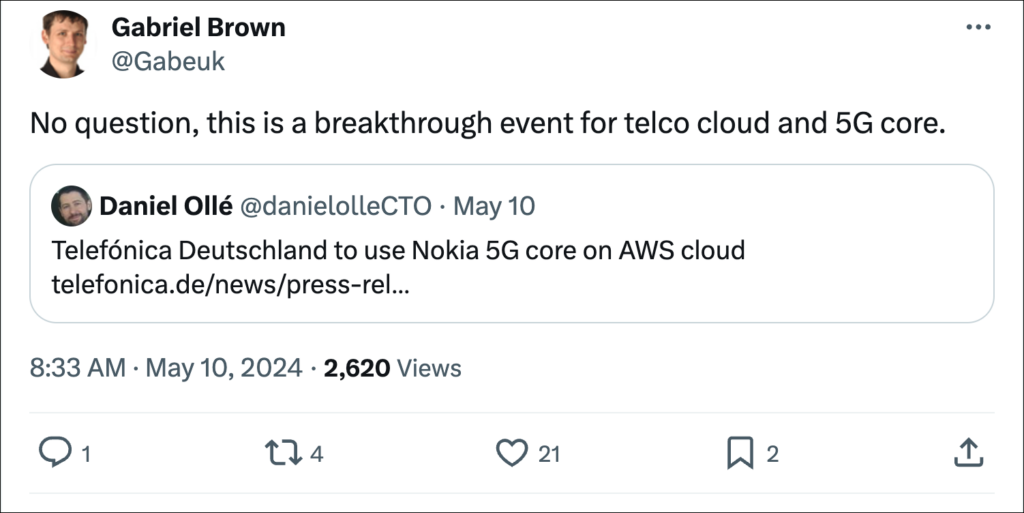Telco’s shift to the public cloud gets real
HOLD THE PHONE, guys. O2 Telefónica Germany, a major telco player, just sent shockwaves through the industry by going all-in on the public cloud for its NETWORK. This isn’t some small-fry operator; it’s a Tier-1 telco making a massive bet on the public cloud. Yowzers! Until now, conventional wisdom held that telecom giants would cling to on-premise data centers and private cloud infrastructure, especially for their network workloads. But the future is unequivocally in the public cloud.

This move by O2 Telefónica Germany follows similar cloud migrations by other industry pioneers. DISH Network, which is building a greenfield 5G network, has opted to construct its entire infrastructure on the public cloud. It estimates it will build its 5G network for as little as $10 billion, about 50% less than a traditional one. And it’s not alone. Heavy hitters like AT&T in the United States and e& in the United Arab Emirates are also jumping on the cloud train, offloading their network workloads to the hyperscalers.
The common thread among these companies is a recognition that the public cloud offers unmatched agility, scalability, and cost savings compared to the legacy on-premise model. No longer is the public cloud viewed as a niche or risky proposition—it is now being embraced by telecom titans as the foundation for the future.
O2 Telefónica and Amazon Web Services (AWS) score a big win
As part of this big news, O2 Telefónica announced its 5G Cloud Core, a new network built entirely in the public cloud in collaboration with AWS and Nokia. This is the first time a telco is moving its existing network and customers to a new 5G cloud network running on a hyperscaler’s public cloud. The project will start with moving one million O2 Telefónica customers to the new cloud-based network by the end of May. They’ll enjoy an improved network experience due to operational advantages that will allow the telco to update core functions faster and more efficiently. After a trial period of “one to two quarters,” the telco plans to kick off a larger migration, eventually moving up to 40% of its customer base by 2025-2026.
At the helm of this project is visionary O2 Telefónica Chief Technology and Information Officer Mallik Rao, who says they’re “building the network of the future.” He gets it: the new 5G Cloud Core will bring O2 Telefónica into the digital age. The telco will no longer have to worry about servers, compute, and storage. Instead, it will position itself for growth with all the advantages of the public cloud: lower costs, better performance, faster provisioning, scalability, cutting-edge technology, and operational efficiency—all of which create a huge competitive advantage and a crap-ton of savings.
With this move, O2 Telefónica Germany will also set itself up to take advantage of the latest and greatest artificial intelligence (AI) tools as they become available. Telcos operating in the public cloud can move from experimentation to real-world applications through the various services available now, and whatever else rolls out next. Talk about strategic positioning. Your home-grown private cloud can’t do that.
Is this the start of a trend? I hope so. And AWS vice president Jan Hofmeyr indicated that the hyperscaler has those ambitions, that there are more deals with operators in the pipeline, and that most discussions are “about timing versus should we move into the cloud.” This is my dream come true. It’s also proof positive of what I’ve been saying since TelcoDR took over the Ericsson space at MWC21 and built CLOUD CITY.
Microsoft is making moves, too
Microsoft has also been making serious moves with telcos. It’s been on a tear, snatching up AT&T’s network cloud (and the brains behind it) back in June 2021. Microsoft refactored the assets to run natively on Azure, and then began to offer the technology to other telcos. The resulting products are now referred to as Azure Operator Nexus and Azure Operator 5G Core, which e& announced it will deploy as well, becoming the first Middle East (and first non-US) telco to do so. It’s using Microsoft’s 5G packet core tech on the Nexus platform, following the AT&T model. My only question is, who’s next?
Never Say Never
I can tell you who is NOT next: my buddies over at Verizon. Sampath Sowmyanarayan, the CEO of Verizon Business, has dug in his heels, saying, “I will never be putting our core network on a hyperscaler … We need to control it, we need to own the stack, we need to manage through it.” Never? That’s a bold claim when the rest of the industry is moving in the opposite direction. Verizon is taking on the herculean task of managing a zoo of vendors (see picture above) for its private cloud, juggling individual vendor roadmaps, software upgrades, operational stitching, and doing its own hardware refreshes. Meanwhile, the telcos embracing the public cloud are offloading that heavy lifting to the hyperscalers. Private cloud is a fundamentally different approach, and one that’s looking increasingly burdensome.
Telcos have been making moves to the cloud over the last several years, for analytics, charging, and disaster recovery, among other things—but the big question for our industry and the public cloud has been about the network workloads. Some people have said those won’t ever move. Not me. I think we’ll see that the more telcos work with hyperscalers, the more they understand how awesome it is and see the opportunity to improve their network operations, lower the overall cost to build the network, and provide better experiences for their customers. The hyperscalers are friends, not foes.
As the industry places its bets, we’re seeing where the chips are falling for public cloud vs. private cloud. Will the public cloud win? You already know my bet. Public cloud all the way, baby!
Recent Posts

 Get my FREE insider newsletter, delivered every two weeks, with curated content to help telco execs across the globe move to the public cloud.
Get my FREE insider newsletter, delivered every two weeks, with curated content to help telco execs across the globe move to the public cloud.
Listen
The hyperscalers are spending billions in Africa, setting the stage for the public cloud to revolutionize the continent’s telcos. With regulations easing and affordable SaaS solutions growing, African telecoms are poised for an era of growth and success.
Watch
DR sits down with Marc Rouanne, Executive Vice President & Chief Network Officer, of DISH Wireless. They discuss the rollout of DISH’s cloud-native 5G network, its work with AWS, cost savings, and more.
Read
What CNCF landscape look like? Why do we need all these Cloud Native projects?
